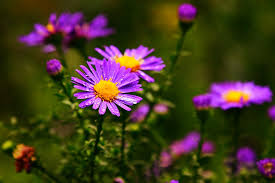The Aster flower: Its Meanings and Symbolism

Asters are a popular daisy-like flower that have grown wild since ancient times. Many people are surprised to learn that the aromatic aster (Symphyotrichum oblongifolium) and the New England aster (Symphyotrichum novaeangliae) that blanket the roadsides along the eastern coast of the United States aren’t really asters at all. These aster look-a-likes have been reclassified, but still carry aster in their common names. The only wild aster in the U.S is the Alpine aster (aster alpinus). Asters have enjoyed a colorful history and are part of many legends.
What does the aster flower mean?
The meaning of the aster flower differs depending on the presentation, but it’s common meanings are:
- Patience
- Love of Variety
- Elegance
- Daintiness
- Afterthought (or the wish things happened differently)
All asters are a symbol of patience and elegance.
Meaningful Botanical Characteristics of the Aster Flower
The aster has been used in a variety of ways throughout history, most commonly as a means to appeal to the gods or ward off evil, but there are some other uses, too.
- The ancient Greeks made an ointment from asters to heal the effects of a bite from a mad dog.
- Asters boiled in wine and placed near a beehive were thought to improve the flavor of honey.
- Asters are used in some Chinese herbal remedies.
The aster flower’s message depends on the circumstances. It symbolizes fond remembrance or wishing things were different when placed on a grave, but symbolizes elegance in your fall decor. Offering a potted plant of asters is a great way to welcome a new friend to the neighborhood.

Comments (0)